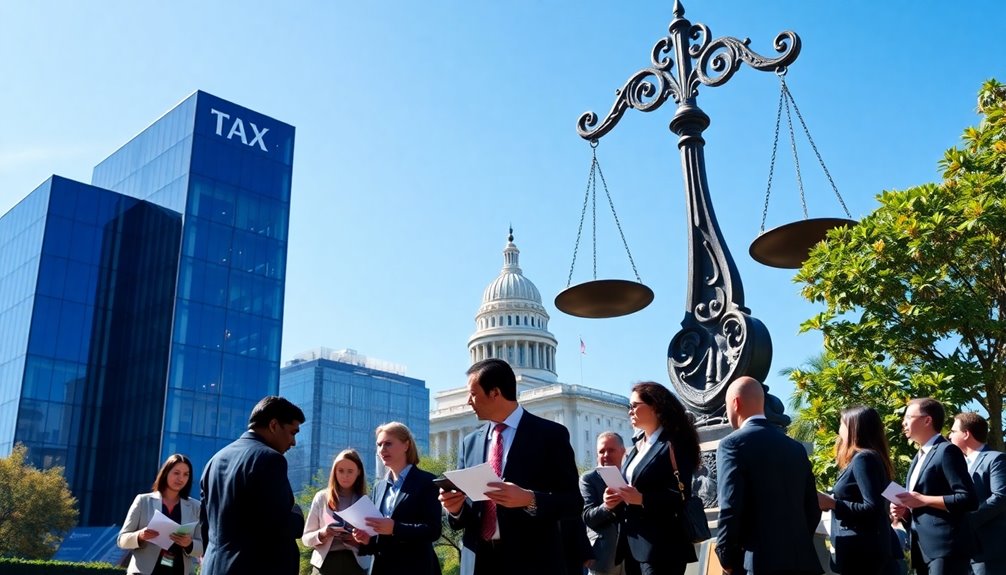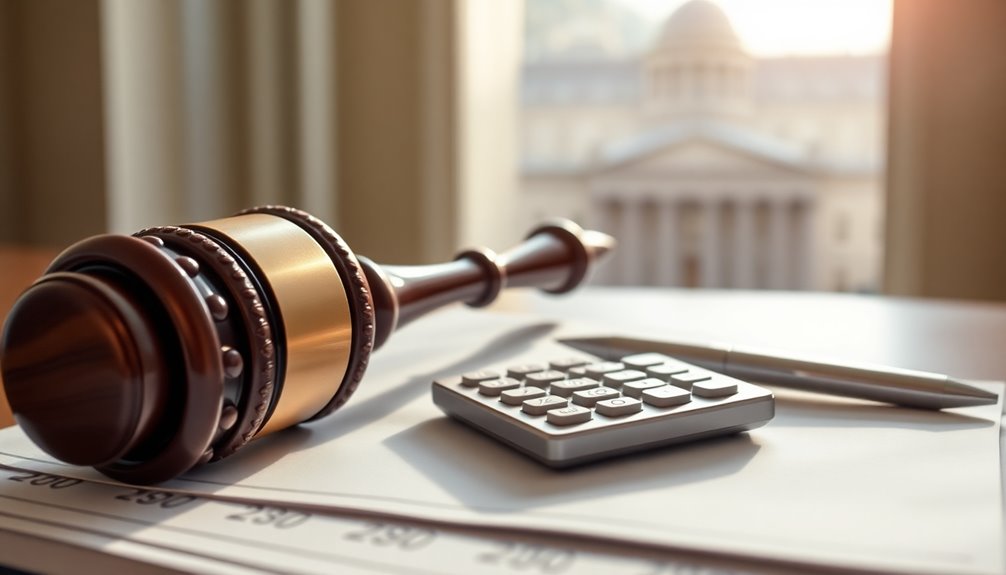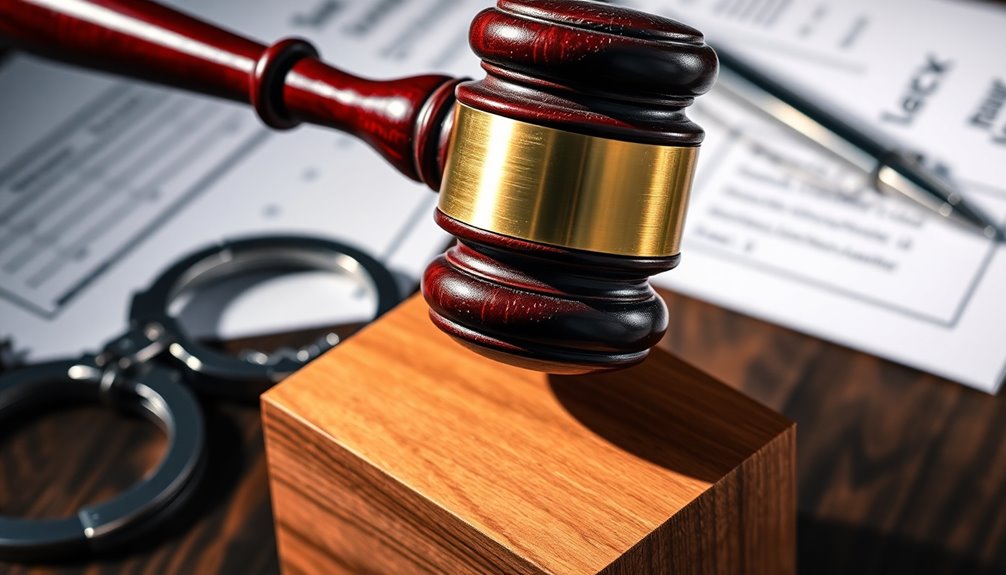Levy taxes are the government's method to collect unpaid taxes through financial charges on your income and property. When you owe taxes, the government can impose levies on things like your wages, bank accounts, or real estate. This process often begins with the IRS sending you a notice, giving you a chance to settle your debts. If you don't respond, they can garnish your wages or seize your assets. Staying informed about these levies can help you manage your taxes better. There's more to understand about how levies work and how to protect yourself.
Key Takeaways
- Levy taxes are financial charges imposed by the government to fund public services, including property tax, income tax, and sales tax.
- The IRS must assess the owed taxes and provide a bill before initiating a levy, including a Notice of Intent to Levy.
- Various assets can be affected by levies, such as bank accounts, wages, real properties, and retirement accounts.
- Taxpayers can respond to levies by paying owed taxes, requesting installment agreements, or seeking an Offer in Compromise.
- Consulting tax professionals can help navigate IRS regulations and provide assistance in negotiating tax debts or contesting levies.
Definition of Levy Taxes

When you hear the term "levy taxes," it refers to the government's authority to impose financial charges on you or your business to generate revenue for public services. Various types of levies exist, including property tax levies, income tax levies, sales tax levies, and business tax levies. Each type targets specific assets or revenue streams, impacting your finances directly.
For instance, a property tax levy is applied to the assessed value of your real estate, while an income tax levy focuses on your earnings, potentially leading to wage garnishments or bank account seizures. Sales tax levies affect transactions, and business tax levies can challenge your company's financial stability. Additionally, the IRS can levy up to 15% of Social Security benefits for unpaid taxes, highlighting the serious implications of tax obligations.
The purpose of these levies is primarily to collect unpaid taxes or fund essential public services, education, and infrastructure projects. However, they can lead to significant consequences for you as a taxpayer, including asset seizure and potential credit issues.
Understanding the definition and types of levies is crucial, as this knowledge empowers you to manage your financial obligations and avoid the pitfalls of unpaid taxes.
Legal Requirements for Levies

Understanding the legal requirements for tax levies is vital for anyone facing potential financial penalties. The IRS must first assess your tax, delivering a bill that outlines what you owe. If you neglect or refuse to pay, they'll send you a Notice of Intent to Levy, along with information about your right to a hearing. This notice must reach you at least 30 days before the levy happens, so it could be delivered in person, dropped at your home or workplace, or mailed to your last known address.
Before initiating a levy, the IRS sends several letters warning you about the consequences of non-payment, culminating in a Final Notice of Intent to Levy. You have 30 days to pay or resolve your tax issues during this period. If you wish to contest the levy, you can request a hearing. Additionally, third parties like banks may become involved. They'll need to respond to the levy within a specified timeframe, informing the IRS of any funds held.
It's essential to know that some funds are exempt, and you can reach out to the IRS to discuss potential resolutions. Furthermore, the IRS must provide fair notice before initiating a levy, ensuring that taxpayers have the opportunity to address their tax obligations.
Types of Property Affected

A variety of property can be affected by tax levies, impacting both personal and business assets. You might find that bank accounts are subject to levies, allowing the government to freeze your funds and seize them to satisfy tax debts.
Your wages can also be garnished, meaning a portion of your salary is withheld to pay off what you owe. Real property, which includes houses, cars, and boats, can be seized and sold to cover unpaid taxes.
Even retirement accounts aren't safe; they can be levied as well. Intangible properties like rental income, dividends, and accounts receivable are also at risk. It is important to note that certain benefits payments are exempt from levies, providing some protection for affected individuals.
However, some assets are exempt from levies, such as workers' compensation, unemployment benefits, and service-connected disability payments. Certain necessary personal effects, like furniture and fuel, have protection up to a certain value.
When it comes to business assets, accounts receivable and business equipment can be levied, along with licenses and commissions. Your life insurance policy's cash loan value and state tax refunds could also be seized to satisfy tax obligations.
Understanding these details can help you manage your assets effectively.
Local Property Tax Calculation

Local property tax calculation is an important process for property owners, as it directly impacts how much you'll owe each year. The first step in this process is determining the tax levy, which is the total amount your local government needs to raise from property taxes. They create a budget and then calculate the tax levy by subtracting revenues from other sources. Once the tax levy is established, it's used to calculate the tax rate. You can find the tax rate per thousand by dividing the tax levy by the total taxable assessed value of all properties in your jurisdiction and multiplying that by 1,000. This rate is typically expressed in dollars per $1,000 of assessed value. To apply the tax rate, you'll need your property's assessed value, minus any exemptions. The property tax amount is then calculated using the formula: property tax = assessed value x tax rate per thousand. Understanding the importance of funding local services is crucial for homeowners to grasp how their property taxes contribute to community needs.
Distinction From Liens and Garnishments

Levying taxes involves distinct processes compared to liens and garnishments, which can often confuse taxpayers. A levy is the direct seizure of your property to satisfy an outstanding tax debt, while a lien acts as a claim against your property, securing the government's interest until the debt is settled. With a lien, your property isn't seized; instead, the government files a public notice to inform other creditors.
On the other hand, garnishments require a court order to compel a third party, like your employer or bank, to withhold a portion of your income or assets. Unlike levies, which the IRS can impose without court intervention, garnishments are typically used for various debts, not just taxes. Tax liens arise automatically within ten days of the first notice of owed taxes, which means taxpayers need to be vigilant about their tax obligations.
While both levies and garnishments can significantly impact your finances, a levy can take entire assets, whereas garnishments usually result in withholding a percentage of your earnings.
Understanding these distinctions is crucial, as they affect your rights and responsibilities in addressing tax debts. Knowing the differences can help you navigate potential tax issues more effectively and avoid confusion regarding your options.
Strategies to Avoid Levies

Understanding the differences between levies, liens, and garnishments can help you take proactive steps to protect your assets.
One of the most effective strategies is to pay your tax debt in full. Doing so immediately stops the levy and all collection actions, eliminating additional interest and penalties. This is also the quickest way to resolve the issue and release any associated liens.
If full payment isn't feasible, consider setting up an installment agreement. This allows you to make monthly payments toward your debt, effectively suspending levy actions. Depending on your situation, you can choose from various types of agreements, which can extend up to 72 months for debts under $50,000. Additionally, keep in mind that the IRS typically initiates a levy after repeated collection attempts, so addressing your tax obligations early can prevent escalation.
Another option is submitting an Offer in Compromise (OIC), which lets you settle your tax debt for less than what you owe. While this requires thorough financial documentation, it pauses collections while the IRS reviews your application.
Lastly, demonstrating financial hardship may qualify you for "Currently Not Collectible" status, pausing collection actions.
Staying on top of your tax filings and seeking professional tax advice can also help you avoid future levies.
Addressing Existing Levies

Facing an existing levy can be overwhelming, but knowing how to address it effectively can bring relief. First, make sure you understand the IRS process. After filing your tax return, the IRS assesses your tax liability and sends a Notice and Demand for Payment. If you don't pay, expect a Notice of Intent to Levy, giving you at least 30 days to respond.
To stop the levy, paying the full amount owed is the quickest solution. If you can't afford that, consider setting up an installment agreement to make monthly payments. This option can reduce penalties, as long as you stay on track. Additionally, be aware that the IRS must assess the tax owed and issue a Notice and Demand for Payment before taking any levy actions.
Another avenue is an Offer in Compromise, which allows you to settle your debt for less than what you owe. Just remember, this must be submitted before the levy takes effect.
Lastly, if the levy causes significant financial hardship, you can request its release by proving your situation to the IRS.
Frequently Asked Questions
Can I Appeal a Levy Decision Made by the IRS?
Yes, you can appeal a levy decision made by the IRS.
You've got 30 days from the Notice of Intent to Levy to request an appeal using IRS Form 12153 or a written request.
Send it to the address on the notice, and during the appeal, the IRS usually won't levy your assets.
If you reach a resolution before the hearing, you can also withdraw your appeal.
How Long Does a Levy Remain in Effect?
A levy can remain in effect until you've fully paid your tax debt, including any penalties and interest.
The duration often depends on the amount owed and your ability to pay. If you demonstrate financial hardship or negotiate a payment plan, you might shorten the levy's duration.
Communicating with the IRS promptly can help, so don't hesitate to seek professional advice to address the situation effectively.
What Are the Penalties for Ignoring a Tax Levy?
If you ignore a tax levy, you face serious penalties.
The government can hold you liable for the full value of the property not surrendered, plus interest on unpaid amounts. You might incur a 50% penalty for non-compliance and additional fines for ignoring IRS notices.
This can lead to legal actions, credit score damage, and the seizure of assets or wages, significantly impacting your financial stability.
Don't underestimate the consequences.
Can My Bank Refuse to Comply With a Levy?
Your bank can't simply refuse to comply with a levy.
Once they receive a Notice of Levy, they're required to freeze your funds and may have to surrender them to the creditor or IRS after a specified period.
They can only challenge a levy if they can prove they don't possess the funds or if the levy is incorrect.
Non-compliance could lead to penalties, so they typically follow the legal requirements closely.
Are There Exemptions for Certain Types of Income From Levies?
Yes, there are exemptions for certain types of income from levies.
You'll find that wages, unemployment benefits, and specific pension payments often qualify for exemptions.
If you have dependents or file under particular statuses, you may also benefit from additional exemptions.
Keep in mind that not all income is exempt, so it's essential to understand which types apply to your situation.
Always check the latest guidelines to stay informed.
Conclusion
In summary, understanding levy taxes is crucial for managing your finances effectively. By knowing the legal requirements and types of property affected, you can better navigate local property tax calculations. Remember, levies differ from liens and garnishments, so it's important to recognize these distinctions. If you're facing a levy, consider strategies to avoid them and address any existing issues promptly. With the right knowledge, you can take control of your financial situation and protect your assets.









